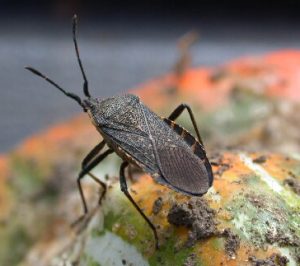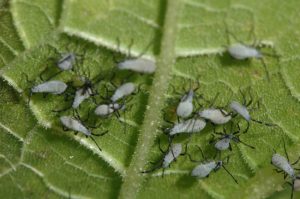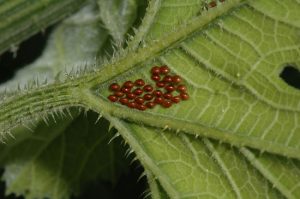If your vegetable garden includes squash, pumpkins, or cucumber, beware of squash bugs. These garden pests frequently attack the leaves of these plants, resulting in wilted or stunted plants that eventually die, especially if the plants are in their young stages. These pests are best controlled through an incorporation of various pest control methods that include the use of insecticides.
How to Identify Squash Bugs
Squash bugs are large gray-black bugs measuring about 1/3 of an inch. These insects use their piercing mouthparts

Adult Squash Bug
to suck sap from plant tissues. Adult squash bugs have wings as well, and can usually be seen crawling along plant stems and leaves. Their wing covers have brown or orange stripes.
Squash bug nymphs, on the other hand, are much smaller, measuring only a few centimeters. They possess light grey bodies with small black legs which they use to crawl across plants. They do not develop wings until they are adult squash bugs. In addition, some nymphs, i.e. those that are the youngest, are green in color, gradually darkening to a brownish-gray as they mature.
As can be expected, the eggs are the smallest when compared to squash bugs in more mature stages. Each egg measures about 1/16 inch and is bronze in color. Eggs can often be found in clusters of about 20 or more on the underside of squash or pumpkin leaves.
The Life Cycle of Squash Bugs
Like many other garden pests, a squash bug’s life typically includes a period of overwintering, where adult squash bugs find cover during winter season under rocks, plant debris or other forms of shelter. With the approach of spring, these bugs emerge. They then search for food and mates. Once mating is successful, female squash beetles lay

White bodied squash bug nymphs
their eggs on the underside of squash, melon, or pumpkin leaves.
Eggs do not take long to develop. In fact, clusters of eggs typically hatch in about 10 days, releasing tiny nymphs in their wake. These nymphs will further develop for about 4 to 6 weeks before becoming adult squash bugs. Each year results in a new generation of squash bugs that can be very numerous in cases of a serious infestation.
Signs of Squash Bug Infestation
One of the clearest signs of an infestation involves the sight of squash bugs themselves, whether as eggs, nymphs or adults. These can be easily identified through thorough examination of leaves, stems, and the base of plants. In addition to spotting these bugs in your garden, there are other signs of infestation that gardeners need to look out for. They include the following:
- Yellow Vine Decline Disease: Some squash bugs are vectors of the yellow vine decline disease. When the squash bug carrying the bacteria that causes the disease and pierce plants tissues with their mouthparts, they easily transfer the disease. It can result in the death of plants, as well as yellowing leaves or wilting.
- Wilting Leaves: Squash bugs affect the nutrient supply of the plants they feed on as they suck sap from the plant tissues. Young plants and those that are generally weak will become wilted.
- Stunted Plants: Another sign of squash bug infestation involves stunted plants. If you notice that your pumpkins, melons, or squash crops are growing at a slower rate than is usual, thoroughly check the plants for signs of infestation.
Removal and Preventative Procedures of Squash Bugs
As with most pest control situations, early detection is always best. In the case of squash bug infestation, gardeners should also note that squash bugs in their young stages are easier to kill than their adult counterparts. Follow the methods below to prevent and remove squash bugs:
- Keep plants properly nourished and fertilized. Plants that are healthy are less likely to experience serious damage from squash bug populations.
- Crush eggs attached to the underside of leaves: Once you spot squash bug eggs on the underside of

Squash bug eggs on leaf
pumpkin, squash, or melon leaves, be sure to not only remove them but crush them. This will prevent nymphs from emerging.
- Spray nymphs and adults with soapy water: The soapy water is an effective method of killing bugs without using potentially hazardous chemicals. You can use a spray bottle or simply remove the insects by hand and place them in a container filled with soapy water. The effect is the same, i.e., the death of those annoying bugs.
Instore or Chemical Removal
Insecticides are available for the treatment of squash bug infestation both in gardening stores and online. These chemical-based products are best properly researched and implemented via a pest control professional. If, however, you decide to use these insecticides on your own, be sure to follow the instructions as given on the product’s label.

No Comments